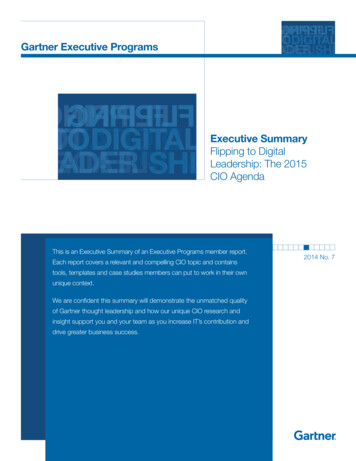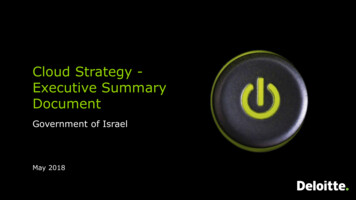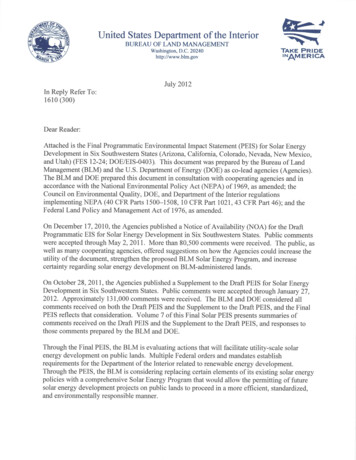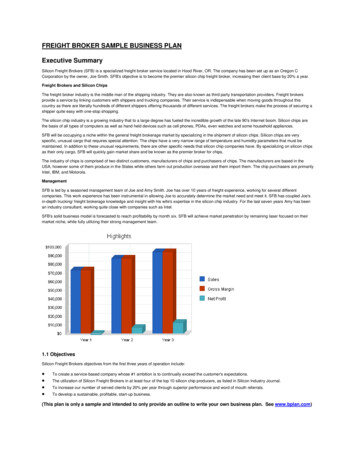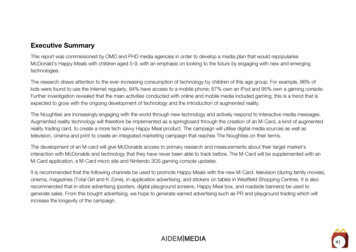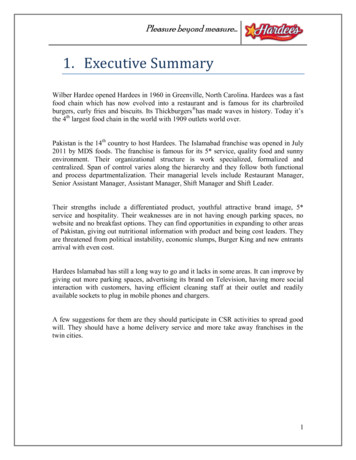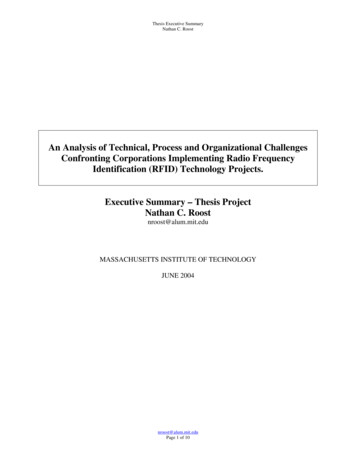
Transcription
Thesis Executive SummaryNathan C. RoostAn Analysis of Technical, Process and Organizational ChallengesConfronting Corporations Implementing Radio FrequencyIdentification (RFID) Technology Projects.Executive Summary – Thesis ProjectNathan C. Roostnroost@alum.mit.eduMASSACHUSETTS INSTITUTE OF TECHNOLOGYJUNE 2004nroost@alum.mit.eduPage 1 of 10
Thesis Executive SummaryNathan C. RoostExecutive SummaryThe purpose of the thesis is to identify challenges that are being addressed by companiesimplementing RFID related technologies in a variety of supply chain management applications.The test engagements undertaken by companies are intended to investigate the economic,functional and process related benefits that might be derived from adoption of this emergingtechnology.Field research uncovered challenges and possible solutions being developed by companies, inaddition to understanding the impact of challenges may have on wide spread adoption of RFIDtechnologies. The challenges observed in this research project were evaluated using a simpleanalytical framework, and case studies were developed to provide summaries of current RFIDpilot project activities.nroost@alum.mit.eduPage 2 of 10
Thesis Executive SummaryNathan C. RoostResearch Project BackgroundRecent attention on RFID technology applied to supply chain management within the boundariesof an enterprise and between trading partners is causing companies to experiment with thistechnology by initiating proof of concept projects. These test engagements look to investigatethe economic, functional and process related benefits that might be derived from adoption of thisemerging technology.The purpose of the thesis is to identify challenges that are being addressed by companiesimplementing RFID related technologies in a variety of supply chain management applications.Field research was conducted via interviews with a ten companies in a cross section of industries.Interviews were conducted with individuals who are responsible for the technicalimplementation of RFID during pilot projects, and with representatives who were accountablefor project management aspect of the RFID pilot. As a result, a number of interviews wereperformed with vice-presidents who oversee entire departments, as well as with managersresponsible for the operations of the field tests.Industries represented in this study include pharmaceuticals, consumer packaged goods,consumer retail, heavy manufacturing and food manufacturing.Applications Areas of TechnologyThe possibility of applying RFID technology to various functions within an organization, andbetween linkages among companies, is expected to lead to more efficient operating procedureswithin a company’s extended supply chain. The research efforts focused on the application ofRFID technology in the following functional areas: Inventory Management – company using EPC/RFID technology in order to automate theoutbound shipping process which will lead to a reduction in warehouse labor that spendstime counting stock that will be departing a company’s distribution center.Product Pedigree – company using EPC/RFID technology to associate raw material andtransportation history of products in order for stakeholders to understand the pedigree ofthe product. Improving “Track and Trace” abilities for products from point of productionto point of consumption is an interesting area of investigation.Facility Security – company using RFID technology to allow for employees to movearound and between company facilities, and associating physical assets to particularemployees.Security Management – company using EPC/RFID technology to increase certainty aboutsecure delivery of containers of product procured certain countries in South East Asia.Classification of Challenges IdentifiedThe challenges uncovered during field research were grouped into the following classifications: Technical – challenges that pertain to physical performance of RFID equipmentperformance, and local information systems performance issues.nroost@alum.mit.eduPage 3 of 10
Thesis Executive SummaryNathan C. Roost Process – challenges that impact procedural activities, from an enterprise wide systemsperspective and from a labor process perspective, within a firm.Organizational – issues that focus on educational and/or interdepartmental involvementefforts associated with deploying RFID technology, both during the pilot effort and whendealing with wider spread adoption activities.In addition of classification of challenges into technical, process and organizational grouping,another analytical framework was developed in order to help further categorize challenges basedupon the following questions suggested during field research: How will the challenge identified impact wider spread adoption of RFID technology atmy firm in the intermediate term?How difficult will the implementation effort be in order to attend to this challenge?Is the issue going to be addressed in the short term (less than one year), or can it beaddressed at some point in the future (greater than one year)?Three Key Reasons for Adoption of RFIDThe data suggested that there are three primary reasons that are motivating companies to testRFID related technologies in a variety of applications throughout the supply chain.The three reasons driving adoption are as follows:1. Adoption to Reduce Costs of Specific Functions within Supply ChainManagement - application of RFID technology to reduce operating costs.2. Adoption in Order to Identify Benefits – application to understand how technologycould be used to develop competitive advantage in the market, or enhance therelationship with an end user of the product sold.3. Adoption to Satisfy Customer Requirement - response to customer request ormandate concerning use of RFID technology.It is important to note that reasons listed as to why companies are considering using RFIDtechnology will greatly impact the scope, timeline, function of individual pilot projects.Summary of Challenges UncoveredThe following challenges were discovered and grouped according to the aforementionedanalytical framework.Technical Case and unit signal interferenceo packagingo product contents Tag placement for case level tracking Impact of radio frequency solutions on consumer health EPC data capture integration effort with existing Warehouse Management Systemnroost@alum.mit.eduPage 4 of 10
Thesis Executive SummaryNathan C. Roost Interference from existing Radio Frequency signals in distribution centersUnderstanding database storage system requirements at both Savant (Edge) and CorporatelevelsProcess Automation of RFID tag application process at case level Understanding customer’s RFID requirements and selection of standards Creation of product groups for RFID test period Association of EPC enabled case and pallet information into traditional electronic transactionprocesses such as EDIOrganizational Creation of cross functional steering committee for RFID efforts Budgeting process and involvement of finance department during pilot Managing unrealistic expectations about RFID within “four walls” of enterpriseHighlights of Case Studies Developed from ResearchField research uncovered a great deal of information about pilot project specifics. The followingtable provides a comparative snapshot of five case studies that were developed during theresearch process to highlight project information.IndustryFoodManufacturingRFID Pilot DriverCustomer MandateRegionUnitedStatesKey StakeholdersSupply Chain Strategy,Information Technology,Production, Quality,Warehousing, PackagingCPG RetailDiscovery ofBenefits - AssetProtectionUnitedStates,PhillipinesAsset Protection,Distribution Strategy,Store Operations,FinanceCPG GroceryRetailDiscovery ofBenefits - AssetManagementHollandHeavyManufacturingDiscovery ofBenefits(CompetitiveAdvantage throughProductDifferentiation) Customer MandateCPG ToyManufacturingCustomer MandateLevel ofTestPallet, CaseThird PartyYes managementconsulting firmKey Challenges1. Signal interference from someSKUs tested - metallic packagingbags/wrappers provided decrease inperformance 2. Understandingeconomic case for unit level tagapplication 3. Keeping attention ofsenior managementContainer,Pallet, CaseYes - C-TPAT(USGovernment)1. Determining type of tag needed forvarious functional applications 2.Getting cross functional teaminvolved in various pilot efforts,especially finance group 3.Developing corporate RFID adoptionplan for 2005 and beyondInformation Technology,Supply ChainManagement, StoreOperations,TransportationUnitYes - uniformvendor, laundryservices vendor1. Managing flow of new EPCgenerated data between vendor andcompany ERP system 2. ProvingROI for specific functional application1. Asset management reason foradoption can show strong ROI.UnitedStatesLogistics, InformationTechnology, QualityAssurance, 3 BusinessUnit Reps (light truck,truck, earthmoving)Container,UnitYes - systemintegrationconsulting firmand 3PL vendor1. Developing proprietary solution for"curing" active EPC tags intoproducts (at unit level) 2.Understanding customerrequirements1. Firm believes that EPC/RFIDcompliant product will become acustomer need/want in the future 2.Involve as many business unit headsas possible during all aspects of pilotprojects 3. Get finance involved earlyin process in order to budgetappropriately.UnitedStatesSupply Chain Strategy,Information Technology,OperationsPallet, CaseYes - systemsintegration firm1. Determining how to populate EPCgenerated data at case level into EDIdocuments (ASN) 2. Developingeconomic business case for adoptionat international plant locations1. Interference at case level did notpose problems for toy and gameproduct groups tested 2. Littleinvestigation made into how firm canleverage investment in infrastructureto benefit ERP and other enterprisewide systemsnroost@alum.mit.eduPage 5 of 10Takeaways1. Interference from contents ofproduct and type of packaging didnot develop to be a significant issuewhen conducting field testing at caselevel. 2. Cross functionalrepresentation on pilot team is vital.3. Communication & executivesupport required. 4. Need todetermine how various productgroups/locations are going tobecome compliant1. Provide limited scope for eachpilot project 2. Ensure financedepartment is represented onsteering committee 3. Createbusiness case for each functionimpacted by pilot
Thesis Executive SummaryNathan C. RoostTable 1 - Case Study Comparison SnapshotFramework for AnalysisTwo concepts were used to create the analytical framework in this research project. First, aclassification schema was created in order to sort the issues uncovered during research(technical, process, and organizational challenges). Second, in order to develop a visual guide ofchallenges, a graph was developed which allows for issues to be plotted based on time horizon,impact on RFID adoption at company, and difficulty of implementation.The following example shows one classification, in this case technical challenges, that may beconfronted by the team working on implementing RFID technologies in a pilot project. Thisdiagram is for illustrative purposes only, and can be considered hypothetical example wherechallenges are plotted according to the aforementioned framework for analysis.The size of bubble indicates the difficulty of implementation from a human resource or financialcommitment perspective. Research indicated that companies judge difficulty of implementationbased different factors, including, but not limited to, budget commitment requirement, full timeresources required to complete project, and involvement from number of functional groups within the firm.Figure 1 - Example of Applying Framework – Sample Analysis of Technical Challenges Expected DuringRFID Pilotnroost@alum.mit.eduPage 6 of 10
Thesis Executive SummaryNathan C. RoostThis framework might be useful at companies that are about to initiate a RFID pilot project. Thechallenges that may be expected could be plotted on the graphs in order to visually represent howthe issues are related to one another.Understanding the expectations of your audience which will be contemplating RFID pilotchallenges is important. The proposed framework allows the manager to identify and helpprioritize challenges that might be confronted while working on a pilot project. The followingfigure provides an example of how all identified issues could be plotted on distinct graphs, andhow this form of visual comparison may be considered useful when prioritizing potential orcurrent challenges.Various perspectives may want to be considered as various levels of the organization getinvolved in pilot activities. Therefore, the recommendations are grouped according to theinterests of the following audiences:Director/Vice President Level – representatives who are considering the intermediate andlong term objectives of RFID technology, and are responsible for functional units within anorganization.Project Manager Level – representatives who are responsible, or will be responsible, forimplementing RFID pilot projects, from both a technical and business perspective, in thefield.The framework suggests that there are two important perspectives to understand: strategic andtactical views of the pilot project. The following graph visually describes how different groupscould view all challenges that have been identified.Figure 2 - Example of Strategic and Tactical Perspectives for RFID Pilot Projectsnroost@alum.mit.eduPage 7 of 10
Thesis Executive SummaryNathan C. RoostThe strategic view, or view 1, could be for vice president level representatives who might wantto understand intermediate to long term challenges that the team might face, in addition to thechallenges that may have a high impact on intermediate term adoption at the company. Thetactical view, or view 2, might be more appropriate for managers who are currently working onRFID pilot implementation efforts. This perspective places more emphasis on current issues thatare likely to be faced in the short term, which are expected in the current year of activities.nroost@alum.mit.eduPage 8 of 10
Thesis Executive SummaryNathan C. RoostRecommendations from Field ResearchThe proposed framework provides a method to sort potential challenges might be confrontedduring the project, and may allow a manager to develop an understanding of the strategic andtactical nature of the issues that will be addressed. As previously discussed, suggestions in thissection have been drawn from the development of case studies and observation of challengesduring the research assignment.The following suggestions might be useful to members of various audiences who are consideringengaging in RFID technology related, pilot activities:Suggestions - Director/Vice President Level Attempt to get high level support for RFID projects – Try to involve those above you inthe organization.Try to involve your finance department in RFID pilot projects and on corporatestrategy/steering team – Return on Investment may need to be proved to financedepartment before budgeting can occur for wider spread adoption of this technology. Getcorporate finance department to take active role in pilot projects.Begin to engage sales and account management teams during RFID pilot projects – Tryto spread RFID responsibilities across functional groups, and not let only a small numberof groups drive the effort within your company. Customer facing functional groups maywant to be involved in pilot testing activities.Consider leveraging RFID investment to derive internal process efficiencies if respondingto customer mandate – Some pilot projects focused on retailer mandate are taking upresources, but try to develop business cases for additional benefits from EPC and RFIDgenerated data.Create RFID education materials that can be distributed to various audiences – Groupswithin your organization might have a different understanding about the technology, andRFID application needs. Perception of uses of RFID technology, and how it will impactthe organization, might be different across sales, production, quality assurance, andmaterials management departments.Suggestions – Project Manager Level Attempt to proactively develop strategies to rollout technology to other plants and regions– It might be useful to not to wait for additional adoption plans from one customer, suchas Wal-Mart, who might be encouraging RFID requirements in the form of a mandate.Attempt to plan as if your company is looking to embrace RFID technology withoutpressure from customers.Create separate pilot projects for application of RFID to various functions withincorporation – A number of different groups within the enterprise might want to conductpilot projects on their own. Managers may want to encourage various project teams toshare pilot objectives and results with other groups involved in the testing of RFIDtechnologies.nroost@alum.mit.eduPage 9 of 10
Thesis Executive SummaryNathan C. Roost Consider developing new classification of products when thinking through RFID testingin the field at case and unit level – some companies might not be able to rely upontraditional product groupings for the purpose of RFID testing during pilot activities, sonew classifications might be useful for testing purposes.Try to think that adoption of EPC/RFID technology will be different to adoption lifecycle of bar coding in retail environments – RFID technology has the potential to impactmore processes within your company, may cost more to adopt across your distributionand production network, could require more attention around privacy and informationownership issues, and will vastly multiply your data storage requirements in someenterprise wide systems applications.Address privacy issues with employees, and then with customer groups – end customersof certain products may be concerned about privacy issues with the use of EPC and RFIDtechnology.During research, it became apparent that the process and organizational challenges may requirethe most attention in order to increase RFID adoption within an organization. While thetechnical challenges that are important and should not be minimized, there are significant issuesconcerning change management around internal functions and enterprise procedures that shouldbe recognized at this point in time.Research SummaryThe research assignment was captured current RFID implementation challenges from fieldresearch, and provided a simple analytical framework with which challenges can be examined.The listing of challenges identified was not exhaustive, but has been depicted in order to providesome insight into the current technical, process and organizational challenges that are prevalentin RFID pilot projects today. In addition to uncovering challenges, three key adoption driverswere discovered and these reasons for adoption are driving the structure of RFID pilots in thefield.Several field case studies were developed to provide anecdotal summaries of current RFID pilotproject activities, and provide context for the technical, process and organizational challengesthat were uncovered during the field research process.nroost@alum.mit.eduPage 10 of 10
Thesis Executive Summary Nathan C. Roost . between linkages among companies, is expected to lead to more efficient operating procedures within a company’s extended supply chain. The research efforts focused on the application of . The following example shows one classific
